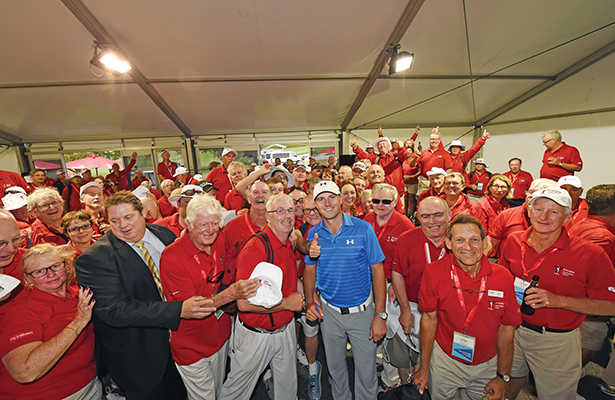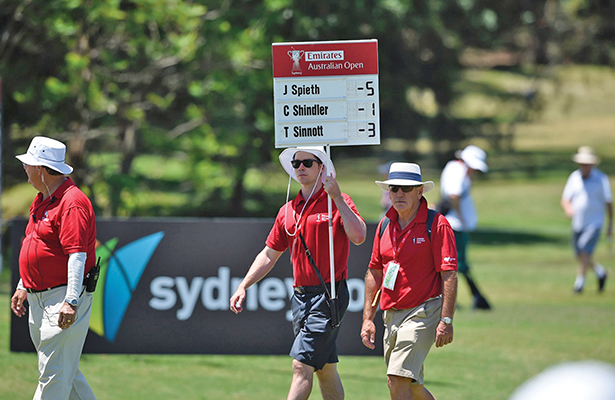Australian Golf Digest ventured inside the ropes and discovered why volunteers are the real tournament heroes.
Like any golf tournament, the 2014 Australian Open simply wouldn’t have gone ahead without the tireless efforts of dedicated volunteers. More than 450 unsung heroes donned red polo shirts and worked day and night across 35 different roles to ensure our national championship ran smoothly each day – for both the players and the fans. But what is the reward for such unpaid labour? Well, after going undercover and inside the ropes, I can tell you it’s the privilege of watching professional golf from the best seat in the house.
Volunteers are the backbone of golf tournaments worldwide – the US PGA Tour alone relies on more than 100,000 volunteers annually to run its tournaments. Though on a much smaller scale, the Aussie summer of golf also depends on a labour of love from the public. So with the help of Australian Open chief marshal Julian Emery, Australian Golf Digest went inside the ropes at The Australian Golf Club to experience first hand what it’s like to be a tournament helper.
The tournament was Emery’s fourth stint as chief marshal after running the volunteers at the 1997, 2004 and 2007 Australian Opens.
“People don’t realise how much they actually get out of volunteering until they do it themselves,” says Emery, a 25-year member of The Australian Golf Club.
“It’s an incredible experience; you’re right there with the players, whether they’re Adam Scott or an international star. You’re walking comfortably inside the ropes when 35,000 others have to walk outside of the ropes.
“No tournament in the world would exist without volunteers – The Masters, the US Open or the Australian Open. But the rewards volunteers get for their help are far greater than what the tournament gets out of them.”
The Australian Open requires between 12 and 14 marshals on each of the 18 holes, as well as several other duties. After partaking in the following four roles, watching golf tournaments may never be the same again.
ROVING MARSHAL
Roving marshal is an important role only dispatched for the marquee groups, which attract the biggest crowds and thus potential trouble. A roving marshall sits behind the playing group and acts as a backup for the volunteers stationed on that particular hole. When a golfer addresses the ball, a rover assists the hole marshals in quieting the crowd and looks for any fan attempting to walk into the player’s line of sight or disruptively trying to take pictures. Assigned to the marquee group of world No.1 Rory McIlroy, 2006 US Open champion Geoff Ogilvy and recent PGA Tour winner Matt Jones in the second round, my work was cut out for me.
★Highlight★ I was able to watch the golfing phenomenon that is McIlroy hit shots from several metres away for the entire round. I was close enough to hear McIlroy discussing club and shot selections with caddie JP Fitzgerald and the conversations with his playing partners, such as describing his new Nike Vapor driver as “the best driver I’ve ever hit” to Ogilvy while waiting on one of the tees. But the moment that stood out was seeing McIlroy toss his ball to a young fan on the tee of the par-5 14th hole, after making bogey on the previous. The look of adoration of the young boy’s face was priceless; knowing he’ll never forget the day the world’s best golfer handed him a ball.
McIlroy went on to eagle that hole.
SCORER
Arguably the most demanding role in volunteering, the scorer is not only responsible for communicating the scores of each player in their assigned group back to the tournament base, but also for recording the exact course of play for each golfer. The scorer follows each player from shot to shot, marking on their clipboard [right] whether the player hit the fairway, how many strokes they took to find the green or greenside bunker, how many putts they made and the individual scores for each hole. The scorer also wears an earpiece and must hear the scores from every single group in the field being sent back to base, which can get confusing.
★Highlight★ Being involved in the thick of the action – both the play and the running of the tournament. It’s the closest one can possibly get to the players without carrying their clubs and you’re guaranteed to watch every shot uninterrupted – because you have to. Having the media centre rely on you to report the scores back to base is a huge thrill and requires the utmost concentration. Plus, you get a clipboard!
SCORE CARRY
A role that, like the scorer, demands complete attention for every single shot. The score carry dons a leather strap and holster – in which the large and awkward scoreboard sits – to relieve some of the strain of holding it for five hours. The square scoreboard feels like you’re holding a ship’s sail and you’re at the mercy of the wind. The job is to follow the playing group closely and count how many shots it took each player to finish the hole, adjusting the overall scores on the board accordingly. The score carry must be aware of each player’s score in relation to par and change (or leave if the hole score is par) as soon as the putt finds the bottom of the cup, before exiting the hole immediately after the playing group. I was lucky enough to carry the scoreboard for the second last group in the third round, which included eventual champion Jordan Spieth, as well as American Conrad Shindler and Aussie amateur star Todd Sinnott (Wow, he can drive the golf ball!).
★Highlight★ Having Spieth look at the scoreboard. After parring the fifth hole and probably disappointed he had let a birdie opportunity slip on a par 5, Spieth glanced at the scoreboard I was carrying. Knowing that a player (and the eventual winner) is looking at your scoreboard and thinking about the next move delivers a feeling of professional involvement with the tournament.
HOLE MARSHAL
One of the most important roles in the tournament, hole marshals are responsible for ensuring players are able to focus on each shot without distractions. Advances in technology, particularly smart phones, have made this job even more important. The marshals need to be vigilant and possess a good level of golf awareness, particularly when fans are in danger of walking into a player’s line of sight before a shot. For example, Matt Jones has one of the quickest pre-shot routines in world golf – if you blink, you miss his strike. Knowing such intricacies can help a marshal stop walking fans who may think they have another five seconds before players such as Jones hit the ball.
★Highlight★ Knowing how much the players rely on you to stop the fans walking into their vision and from taking photos during their swing so they’re able to concentrate on the shot at hand.

Being a volunteer is an incredible way to watch golf with an invaluable behind-the-scenes feel. There’s so much more to a tournament than what you see on television or from outside the ropes – walking with the players and hearing their conversations; getting an insight into the tournament; not having to fight your way through the crowds but instead feeling the fairways under your feet; seeing the course from the perspective of the players; and playing a part in helping the tournament to operate smoothly. Once you’ve experienced it, it’s impossible to go back. The perks of the ‘job’ explain why the majority of volunteers do it for years on end.





